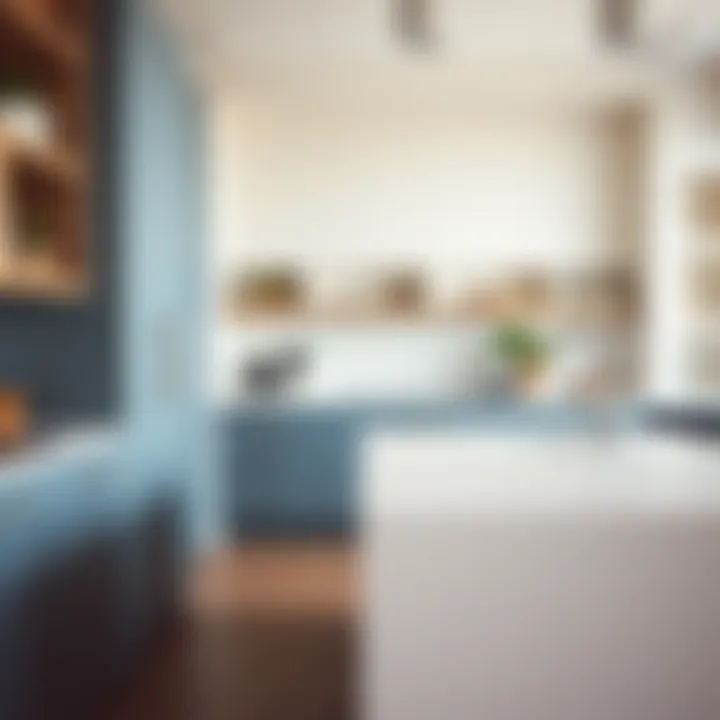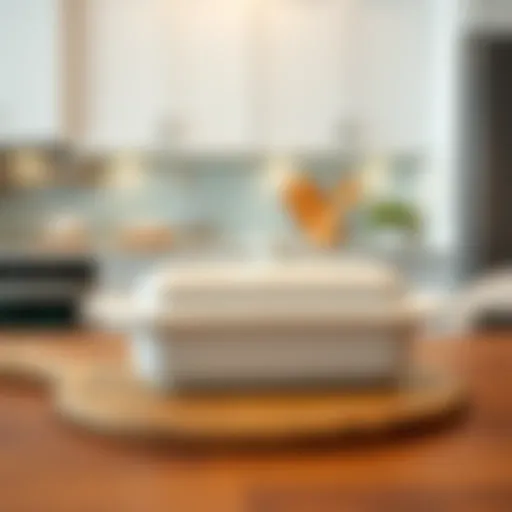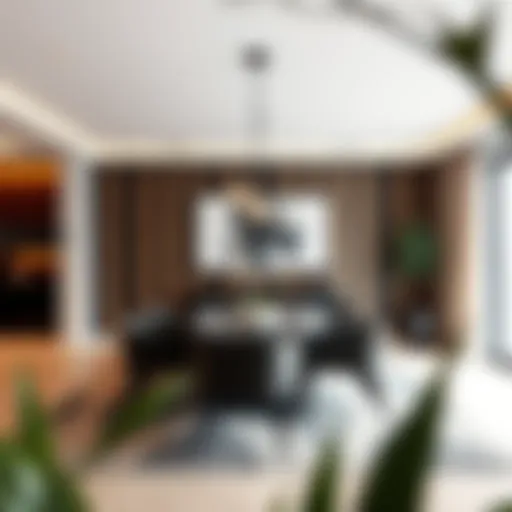Mastering Formica Sample Orders for Design Projects


Intro
In a world where interior design constantly evolves, choosing the right materials has become a vital part of creating a space that reflects both personality and functionality. Among these materials, Formica stands out for its durability and aesthetic appeal. This article seeks to shed light on the process of ordering Formica samples, catering specifically to homeowners, decorators, and DIY enthusiasts who are eager to make informed choices.
Understanding the significance of samples is crucial. They offer a tangible way to experience textures, colors, and finishes, making decision-making easier. Without these samples, navigating the vast array of options can feel like trying to find a needle in a haystack. Not only do samples provide clarity, but they also guide the selection to ensure that the chosen materials harmonize seamlessly with the overall design vision.
As we explore various facets of procuring Formica samples, we'll also touch upon design trends and material innovations that align with contemporary needs. The aim is to empower readers with the knowledge they need to elevate their projects using Formica's versatile offerings.
Understanding Formica
Understanding Formica is pivotal for anyone involved in design, construction, or home improvement. This resilient surface material has a long history and a multitude of applications, making it a favorite among homeowners and professionals alike. By grasping the nuances of Formica—its origins, its components, and its various types—individuals can make informed decisions that ultimately enhance their projects.
Origin and Evolution
Formica dates back to the early 20th century, originating as an alternative to the more fragile materials available at the time. The first sheets were made from layers of paper saturated with melamine resin. Over the years, Formica has evolved into a diverse range of products that cater to different aesthetic and functional needs. Initially, it was used primarily for countertops and tabletops in kitchens, but its durability and versatility have expanded its use into other areas such as wall panels, cabinets, and even flooring. This trajectory highlights Formica's ability to adapt alongside customer trends and preferences.
"Formica is not just a surface; it's a testament to the evolution of interior design that reflects both style and function".
Components and Structure
The unique structure of Formica is part of what sets it apart. Generally, it consists of several layers: a backing layer, core layer, and decorative top layer. The backing often comprises a durable base like fiberboard, which provides sturdiness. The decorative layer is where the magic happens—here, intricate patterns and colors can be printed or laminated to fit various design tastes. Melamine resin is infused into these layers, creating a material that resists heat, scratches, and moisture, giving it a reputation for durability in high-traffic spaces. This multi-layered composition not only results in a visually appealing finish but also grants significant functional advantages.
Types of Formica Products
There’s no shortage of variety when it comes to Formica products. For instance, standard laminate sheets offer a cost-effective solution for desktop applications, proving both stylish and practical. Custom designs allow homeowners and designers alike to tailor surfaces to their specific tastes and needs, whether through unique colors or graphics. Additionally, there are commercial-grade options designed to withstand heavy use in businesses like restaurants or retail. It's crucial to consider the setting and intended use when choosing from this diverse lineup; not every Formica product will serve the same purpose. By understanding these distinctions, individuals can tailor their selections to align with not only their style but also their practical requirements.
The Importance of Samples in Design
When undertaking a design project, especially one involving materials like Formica, the significance of ordering samples cannot be overstated. Samples serve as the bridge between abstract ideas and tangible materials, allowing homeowners, decorators, and designers to make informed choices. The tactile experience of a sample often reveals nuances that pictures simply cannot convey. Factors such as color, texture, and finish can transform a room, making the selection process both crucial and often challenging.
Adapting to Aesthetic Preferences
Each person has unique tastes and styles. What might please one homeowner could leave another cold. By obtaining Formica samples, you open the door to exploring personal aesthetic preferences in a practical way. Samples allow you to see how different colors and patterns harmonize with your existing decor or the vision you have for your space.
For instance, imagine a bright blue sample juxtaposed with a warm oak surface; such contrasts can either enhance or clash dramatically depending on the surrounding elements. The hands-on experience with samples not only aids in visualizing these comparisons but also helps in affirming your choices before a full commitment. Instead of rolling the dice on blind selections off a website, visiting a showroom or ordering samples online can ensure that the final choices resonate with your style.
Evaluating Texture and Finish
Another critical aspect to consider is the texture and finish of the materials. Formica comes in a variety of finishes — from glossy to matte — each offering a different level of visual intrigue and practical usability. A glossy finish might facilitate cleaning but may show fingerprints easily, while a matte surface can create a rich, warm ambiance but is generally harder to maintain.
By handling the samples, you can ascertain how they feel to the touch. Does the finish feel warm and inviting, or does it feel off-putting? Does it scratch easily? The right texture can significantly impact not just aesthetic values but functionality as well, especially in high-use areas like kitchens or family rooms.
Testing Durability and Usability
Ultimately, materials won't serve any purpose if they don’t hold up over time. The next consideration while navigating samples involves assessing durability and usability. Formica, known for its resilience, typically stands up against scratches, stains, and heat. However, the specific variety matters.
For example, a standard laminate might be great for light-duty applications, yet if you’re looking at a kitchen countertop that sees heavy daily usage, opting for a thicker, more robust laminate could save you money in the long run. Testing samples in your actual space — even laying them on surfaces where they might be used — enables you to evaluate their practical aspects closely.
"The tactile experience you gain from samples is irreplaceable, offering insights that photos simply cannot."
For more detailed information on material durability and maintenance, you can visit Wikipedia's page on Laminate materials.


Navigating the Order Process
When embarking on a journey of selecting Formica samples, figuring out the order process can feel a bit like navigating a ship through uncharted waters. It's not merely about choosing pretty colors; it's about understanding the mechanics behind ordering those samples effectively. This section explores the critical elements that play a significant role in this process, aiming to arm homeowners, designers, and decorators with the essential knowledge needed to make informed choices.
Identifying Reliable Suppliers
Finding a dependable supplier is akin to striking gold in a bingo hall. With numerous options available, the quest can be quite daunting. Some key considerations include:
- Research and Reviews: Scour the internet for feedback on potential suppliers. Websites like Reddit or Facebook can serve as platforms for unfiltered opinions. Customer reviews offer candid insights into reliability and service quality.
- Industry Certifications: Look for suppliers with certifications that assure adherence to industry standards. This not only ensures quality but also signals that they are a credible source.
- Sample Variety: A good supplier should offer an extensive range of samples, accommodating various preferences and needs. Look for those who showcase diverse designs and textures.
By doing your homework, you can avoid the pitfalls of unreliable suppliers and hone in on those who deliver quality and satisfaction.
Placing Your Sample Order
So, once a suitable supplier is on board, what now? This part of the process isn't just about clicking a button; it's also about clarity and precision. Consider these pointers when placing your sample order:
- Specify Your Needs: Be as detailed as possible about the samples you want. If it’s a specific design or a particular color palette, communicate that clearly. Misunderstandings can lead to delays, which is something no one wants.
- Sample Sizes: Not all samples come in the same size. Check if the supplier offers real-life size samples or smaller demo pieces. Sometimes, having a larger piece can make the decision easier when visualizing the final result.
- Use Online Tools: Some suppliers provide tools to visualize the samples in your space, making it easier to envision how they'll fit into your overall design. Make sure to take advantage of these tools to ensure you’re making the right choices.
The process can be simplified by treating it with the same meticulousness you would when ordering a new piece of furniture.
Understanding Costs and Shipping
Cost is often the elephant in the room. Getting caught off guard by shipping fees or hidden costs can spoil your excitement. To navigate these waters effectively, think about the following:
- Transparency in Pricing: Choose suppliers who provide clear, upfront pricing details. Look for any additional fees associated with sample shipping, as they can sometimes add up unexpectedly.
- Shipping Methods: Assess the shipping options available. Some suppliers may offer expedited services for a fee, while others might have slower but more economical methods. Knowing your timelines can help you make better decisions.
- Return Policies: Don't forget to check the return policies. Although you should be certain of your choice, sometimes a sample doesn't meet expectations once it arrives. Having a straightforward returns process can alleviate subsequent stress.
"The devil lies in the details." Understanding these costs can pave the way for a smoother buying experience and avoid potential headaches later.
Navigating the order process for Formica samples is an exercise in preparation and understanding. Suppliers, orders, and costs may seem like small cogwheels, but they play vital roles in the bigger picture of successful design projects. With this knowledge tucked under your belt, you’ll find the journey towards creating beautiful spaces becomes much clearer.
Types of Formica Samples
When embarking on a design project, the type of Formica samples you choose can make a significant difference in the outcome. Each type carries its unique advantages, not just in aesthetic appeal but also in functionality, application, and even cost-effectiveness. Understanding these types is key for homeowners, interior designers, decorators, and DIY enthusiasts alike.
Standard Laminate Samples
Standard laminate samples are essentially the bread and butter of Formica products. They come in a wide array of finishes and colors, providing both flexibility and a well-grounded starting point for any design. A laminate sample usually reflects the true qualities of texture, gloss level, and color saturation, which can be hard to gauge online or even in showrooms.
When selecting standard laminate samples, keep in mind that these options are perfect for high-traffic areas. They tend to be resistant to scratches and stains, making them not just visually appealing but also practical for daily wear and tear. Homeowners often lean towards traditional finishes such as matte, gloss, or textured designs, which can complement a variety of styles, from contemporary to rustic.
Be sure to consider how the sample looks under different lighting conditions. What may seem bright and vivid in one setting could appear dull in another. Testing these samples in various lights helps ensure you won't be caught flat-footed later on.
Custom Designs and Colors
For those willing to step off the beaten path, custom designs and colors offer a unique avenue for personal expression. Whether you want something that mirrors a favorite piece of art or a design that encapsulates your vision, custom samples allow that creativity to take flight. However, custom samples often come with longer wait times and higher price points.
The beauty of custom samples lies in their tailored approach. You can choose everything from color palettes to intricate patterns, which means your project can be as unique as your imagination allows. But remember, while it’s exciting to dream big, combining too many bold elements can create a chaotic space. Instead, consider focusing on one standout feature.
Gathering customer feedback on these designs can drastically improve your final choice. Moreover, reaching out to a designer or decorator can provide that extra insight into how your unique piece will fit into the bigger picture.
Commercial versus Residential Options
Choosing between commercial and residential options is less about preference and more about purpose. Each is designed with specific environments in mind. Commercial options are engineered to withstand high traffic and heavy usage. They’re perfect for public spaces—like cafes or offices—where durability is key.


On the flip side, residential options may prioritize design elements or comfort levels that enhance the feel of a home environment. These can include softer finishes or more inviting color choices.
When considering what to order, assess the intended space. For a bustling shopfront, commercial-grade Formica can handle wear and tear effectively. But for a cozy kitchen or family room, a residential option might add the warmth or charm you desire.
Choosing the right type of sample ensures that whatever project you’re working on has longevity, appeal, and functionality—all crucial attributes for a successful design.
Leveraging Samples in Your Project
Utilizing samples effectively can dramatically change the way a design project unfolds. This section examines how integrating Formica samples in your work ensures a seamless blend of functionality and aesthetics. Not only do these samples allow you to visualize your ideas, but they help underscore the importance of informed decision-making throughout the design process. By having physical examples at hand, clients and designers alike can ensure that choices made align both with the envisioned objective and the practical aspects of material use.
Incorporating Colors and Patterns
When designing a space, the colors and patterns chosen play a pivotal role in defining the ambiance and mood. Samples of Formica allow designers to see how different colors and patterns interact in real time with existing light in the space. For instance, a bold teal or a muted pastel can evoke an entirely different feeling when set against varied lighting conditions.
Moreover, the layering of patterns—perhaps a floral wallpaper coupled with a geometric Formica surface—can create a rich tapestry of design. The actual samples provide the tactile experience necessary to appreciate how these elements complement one another. Without the physical samples, one might rely solely on digital representations, which can often misrepresent the final look.
Creating Contrast with Textures
Textural contrast can elevate a design from simple to sophisticated. Imagine implementing a polished Formica tabletop against a matte wooden cabinet. Such combinations not only draw the eye but also create an engaging sensory experience.
Formica samples allow the designer to touch and feel different surfaces—knowing how they would perform in actual use is crucial. For example, a wood-like finish can bring warmth while a glossy surface might add a sleek modern touch. It’s in these samples that the potential for juxtaposing textures becomes evident, encouraging a dialogue between the various materials in your project.
Functional Application in Space Design
Functionality must marry with form to create a practical yet beautiful environment. Understanding how Formica will perform in different settings allows designers to make choices that consider wear and tear in high-traffic areas versus areas with minimal usage. For instance, a rugged, textured finish may be preferred for a kitchen while a smooth surface could be more suitable for a formal dining area.
Samples can also assist in testing the material's resistance to scratches, stains, and heat, essential factors for any furniture or surface application. Real-world applications of samples give a clearer picture of how the material behaves under everyday circumstances, which is critical for ensuring longevity and practicality in design.
"The best way to predict the future of your design is to experiment with samples; they are the key to making your ideas come alive."
Common Mistakes in Sample Orders
Ordering samples for Formica can feel as tricky as navigating a labyrinth. Many people, whether seasoned designers or novice DIY enthusiasts, can easily sidestep critical details and inadvertently set themselves on the wrong path. Understanding these common pitfalls is a vital part of ensuring that the right choices are made right from the start. From misjudging scale to neglecting the role of lighting and overlooking functionality, recognizing and remedying these mistakes can save time, money, and frustration.
Overlooking Scale and Proportions
When sampling Formica, one of the most significant missteps people often make lies in the scale of the samples themselves. It’s easy to be swayed by a beautiful pattern or color displayed in a small swatch, but these can appear completely different when applied to a larger surface. Consider for instance a chic geometric pattern. It might look adorable on a small sample, but when extrapolated onto an entire countertop or vanity, it could overwhelm the space or look completely out of sync.
To avoid this pitfall, always visualize the sample in context. Obtaining larger samples or mock-ups can help you gauge where the materials fit in your intended space. In essence, don’t just take the swatches at face value; measure their potential against the canvas they will eventually inhabit. A mismatch in scale can lead to a design choice that feels jarring instead of cohesive.
Ignoring Lighting Conditions
Another frequent oversight involves failing to consider how various lighting conditions can alter the perception of a color or texture. Natural light has a different effect on a surface compared to incandescent or fluorescent lighting, leading to variations that can be quite stark. A Formica sample might appear warm and inviting in daylight but can take on a duller hue under artificial lights in the evening.
To mitigate this error, it’s important to evaluate a Formica sample under multiple lighting conditions. Take the time to examine your samples in the actual environment where they will be used. Be mindful of where natural light enters your space and how your artificial lights might showcase the colors at night. This kind of diligence ensures that you are happy with your choices, no matter the time of day.
Failing to Consider Functionality
Functionality is the backbone of design, yet it often gets overshadowed by the aesthetic allure of Formica samples. A beautiful finish is pointless if it doesn't hold up to the demands of everyday use. For example, consider the wear and tear that kitchen counters endure. Choosing a laminate that looks stunning but doesn’t withstand spills, cuts, and hot pots can spiral into a costly mistake.
Before committing to a sample, think about how the space will be used. Will it see heavy traffic, or is it in a more decorative setting? Scrutiny of durability ratings and potential finishes that come with a Formica sample can offer invaluable insight. Engage with suppliers to get information on care and maintenance for the samples. A well-informed choice will ensure that your design isn’t just pretty, but practical too.
"In design, every detail counts, and small oversights can lead to big regrets. Pay attention to scale, light, and function to create a space you can truly enjoy."


Taking the time to evaluate each of these aspects can make the difference between a satisfying project and an overwhelming fiasco. Don’t rush through the sample ordering process. Instead, approach it with care, ensuring that each decision aligns with the overall vision of your project.
Feedback and Adjustments
Collecting feedback and making adjustments is an integral step in the journey of selecting Formica samples. This phase allows designers and homeowners to gauge how their chosen materials resonate with others and helps fine-tune final selections. The importance of openly discussing choices cannot be overstated; it provides critical perspectives that might otherwise slip through the cracks. Ultimately, the inputs we receive can dramatically impact the successful execution of a project. It’s not just about picking pretty surfaces—it's about achieving a cohesive look that meets functionality and aesthetics alike.
Gathering Opinions from Others
When working with Formica samples, sharing your insights and designs with others can yield invaluable feedback. Whether it’s friends, family, or professional designers, their thoughts can illuminate aspects you may not have considered. Often, a fresh pair of eyes can see shadow and light that might escape the original creator. Here are a few strategies to effectively gather opinions:
- Conduct informal group discussions: Invite people over, lay out your samples, and ask for input. Their unfiltered impressions can be enlightening.
- Utilize social media platforms: Share images on platforms like Facebook or Reddit to tap into a wider audience. You might be surprised at the depth of feedback you receive.
- Engage in forums or design communities: Websites like Houzz or specialized design forums can provide a treasure trove of opinions from seasoned professionals and enthusiasts alike.
Sharing early thoughts in this manner not only opens doors for insightful feedback but also can spark creativity and lead to innovative ideas you hadn’t initially envisioned. Don’t hesitate to ask specific questions about colors, textures, or how certain options fit into broader design themes.
Making Informed Adjustments
Once opinions are gathered, integrating them constructively is the next crucial step. The feedback process is about fine-tuning, and making adjustments based on collective insights is vital. First, objectively assess the feedback received. Identify any recurring themes that emerge; if multiple individuals comment on a specific color clash or texture incompatibility, it's a hint that you should reassess that choice. Here are some key points to keep in mind:
- Seek clarity on critiques: Always ask for specifics. General comments can be vague, but details can lead you in the right direction.
- Prioritize functionality alongside aesthetics: Adjustments should not only address looks but also usability. For instance, if a beautiful finish is prone to scratching, it might be wise to select a more durable solution.
- Stay true to your vision: While feedback is valuable, ensure your adjustments align with your original design intent. After all, this is your project, and it should reflect your style and purpose.
Finalizing Your Choices
With adjustments in hand, it’s time to put the finishing touches on your Formica selection. This stage often brings both excitement and apprehension. Finalization marks the transition from theoretical choices to practical application. Here is a process to make sure you’ve covered all bases:
- Reassess the samples: Lay out the final selections side by side. This visual review can reveal whether the pieces work harmoniously together.
- Consider logistics: Before sealing the deal, check on supplier timelines and availability to ensure your choices can be delivered as needed.
- Document your final choices: Keeping a record of what you decided and why can be helpful for future projects. This isn’t just about aesthetics; it’s about creating a cohesive narrative that ties your selections back to your original vision and goals.
In closing, feedback and adjustments are not merely administrative steps in the sample ordering process for Formica. They are dynamic elements that enrich design and ensure that the final outcome meets both the practical needs and aesthetic desires of the project at hand. Embrace this stage with openness and creativity.
Future Trends in Formica Designs
The landscape of interior design is ever-evolving, and Formica is no exception. Its versatility has allowed it to adapt to changing trends, making it a relevant choice for many homeowners, decorators, and designers. Understanding future trends in Formica designs is crucial for anyone involved in renovation or new constructions. As people increasingly seek tailored solutions for their spaces, being informed about these trends can facilitate better decision-making, and ultimately lead to successful projects.
Sustainable Practices in Material Use
Sustainability has carved a niche into design conversations, and Formica is responding to this change. The drive for eco-friendly products means that many manufacturers are exploring how to minimize their environmental impact. This includes using recycled materials in their products.
- Locally Sourced Materials: Formica manufacturers are increasingly finding ways to use materials sourced closer to their production facilities. This approach not only reduces transportation emissions but also supports local economies.
- Recyclability: Another aspect is the recyclability of Formica. Homeowners now look for products that can be easily recycled at the end of their lifespan. Understanding how these materials can be disposed of sustainably can make a difference in one's design choices.
- Eco-Friendly Finishes: More options with non-toxic, low-emission finishes are appearing. When ordering samples, it’s wise to inquire about these finishes to catch up with this responsible design trend.
The broader benefit is a cleaner, healthier living environment, ensuring homes are not just aesthetically pleasing, but also safe and sustainable.
Technological Advances in Design
The advent of technology continues to push the boundaries of what is possible with Formica. Advances like digital printing allow for an unprecedented level of customization. Those keen on expressing their unique styles can achieve personalized designs that resonate with their tastes.
- High-Resolution Prints: With vivid colors and intricate patterns, these high-resolution images can transform ordinary surfaces into standout pieces. With techniques like these, the possibilities become endless.
- Smart Materials: Innovations aren’t just in aesthetics; we also see the introduction of smart materials that can adapt based on usage or environmental changes. Such materials can provide practical advantages, like easier cleaning or increased durability.
- Online Design Tools: Software options now allow interior designers and homeowners to visualize how various Formica samples would look in their spaces. This technology helps eliminate guesswork, ensuring more sure-footed decisions.
The beauty of these technological shifts is that they empower individuals to take control of their environments while achieving unique styles simply not feasible in the past.
Emerging Styles and Preferences
As preferences shift, so do the styles that gain traction in Formica selections. Homeowners and builders are becoming bolder, opting for designs that resonate with their lifestyles. Trends show a strong inclination towards blending functionality with striking aesthetics.
- Minimalistic Aesthetics: Many are gravitating towards clean lines and muted colors, allowing for a calm ambiance conducive to relaxation. Choosing samples with soft textures can enrich this minimalistic style without overwhelming a space.
- Bold Patterns: On the flip side, some circles embrace bold patterns and vibrant colors, making spaces feel lively and dynamic. This is particularly evident in commercial environments where customer engagement is essential.
- Natural Inspirations: Designs that mimic natural materials like wood or stone continue to gain traction. This is particularly appealing for those looking to create a cozy yet modern atmosphere.
These trends signal a move toward personalization and individual expression, indicating a departure from generic options and a journey toward design authenticity.
As Formica continues to evolve, staying abreast of these trends is beneficial. Utilizing samples that reflect current styles and sustainable practices can ensure your projects resonate well with contemporary ideals while meeting functional needs.
In summary, understanding the future trends in Formica designs aids homeowners and designers in making informed decisions. Whether it's about sustainability, technology, or emerging stylistic preferences, being aware of these factors can lead to a more fulfilling design experience.















